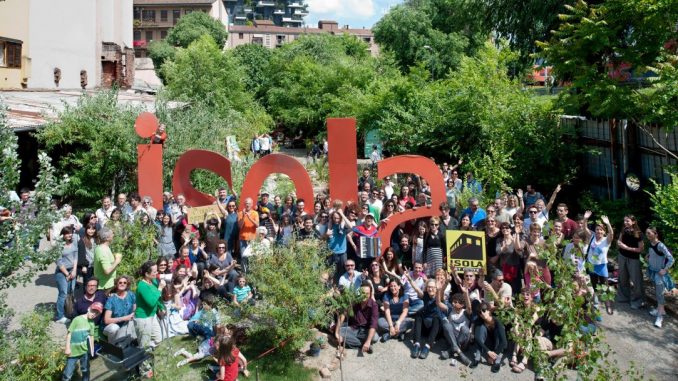
In crossing the Isola neighborhood in Milan, whoever knows Barcelona suffers a kind of déja vu. The same buildings, the same companies, the same destruction as in Poblenou in 2004. Nouvel is replaced by Boeri, and the Universal Forum of Cultures with the Expo 2015.
Everything else is exactly the same: a workers’ neighborhood, inhabited by migrants from the South, segregated from the center of the city (hence the name isola, island), during decades had been targeted for demolition; the bulldozers only entered the neighborhood in the beginning of the 2000s, after structural adjustment programs and political demobilization. The complete demolition of Isola was first proposed in the General plan of 1953, but massive destruction began only sixty years later. Then artists and activists gathered in an old factory they called La Stecca degli artigiani, to promote protests and alternative uses of space (remember Can Ricart?). The Stecca was demolished in 2007, on the anniversary of Italy’s liberation from Fascism. Now a collective book, “Fight-Specific Isola” explains the 12-year struggle against demolitions, and the long decades of neighbors’ opposition against gentrification.

Bert Theis, one of the authors of the book Fight Specific Isola died in mid-September. He was an inspiration for all the cultural project of the neighborhood. This article commemorates his memory.
- Antonio BRIZIOLI (2015) “Storia dell’Isola, il quartiere storico che vogliono cancellare“, Emergenze
- Stefano PORTELLI (2016) “Apuntes de un paseo por Isola Porta Nuova: Milán modelo Barcelona“, blog Seres Urbanos de El País, 22/10/2016.
- AAVV (2013) Fight-Specific Isola: Art, Architecture, Activism and the Future of the City. Milano: Isola Art Center :: a review on Il lavoro culturale :: a video by Antonio Agugliaro for the book’s crowdfunding :: and an account, both personal and political, self-reflexive and complex, of the struggle and of the book: Elvira VANNINI (2012) “Lotta specifica“, UnDo.
- Valentina BUGLI (2006) “Milano e l’Isola che c’è: il quartiere Isola, la Stecca degli Artigiani e Isola TV“, Inchiesta, april-june, pp.126-132.
- Neda AGHABEGLOO, Francesca GIANGRANDE, Paola PISCITELLI, Eleonora SARTORI (2013) “L’arte del conflitto in Isola“, Thesis in Urban Planning, Politecnico di Milano.
- Martina PAGANO (2013) “L’Isola e Porta Nuova: Alla scoperta di un quartiere in mutamento“, Mente Locale, 26 febbraio.
- Otros links desde el barrio: IsolArtCenter :: PianoTerraLab :: IsolaPepeVerde
- On the urban struggles in Milan in the 60s and 70s, see Mario BOFFI et al. (1970) Città e conflitto sociale: Inchiesta al Garibaldi-Isola e in alcuni quartieri periferici di Milano, Feltrinelli [PDF] :: or Andreina DAOLIO (1974) “Le lotte per la casa a Milano”, in Daolio, ed. Le lotte per la casa in Italia: Milano, Torino, Roma, Napoli, Feltrinelli [PDF]. And on the Milanese underclass and the “ligera”, petty criminality of the neighborhoods: Primo MORONI, Ca’ Lusca [PDF] :: Danilo MONTALDI (1961) Autobiografie della leggera [very interesting article on Vice][documentary]. From Isola came the famous “boss” Ezio Barbieri.
- With the great urban changes in Isola a monument to the antifascistist combatants of the neighborhood was moved. Remember the plaque in Poblenou’s Camp de la Bota? “I want peace, but not oblivion…”. Now it is just in the middle of the explanade of the Forum.